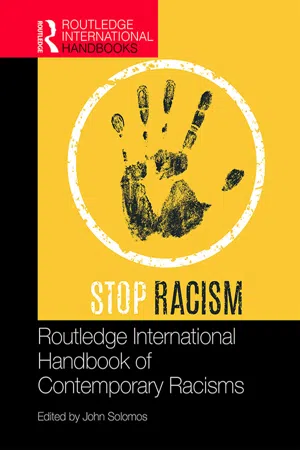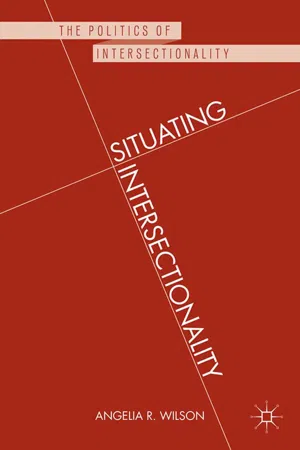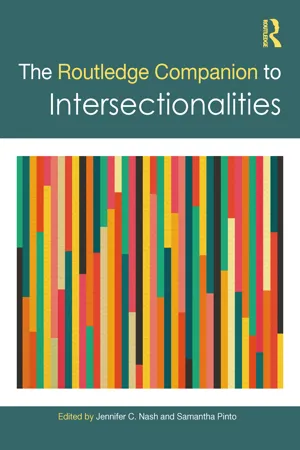Literature
Kimberle Crenshaw
Kimberlé Crenshaw is a prominent scholar and professor of law known for her work in critical race theory and intersectionality. She is best known for coining the term "intersectionality," which highlights the interconnected nature of social categorizations such as race, gender, and class, and how they overlap and intersect to create unique experiences of discrimination and privilege.
Written by Perlego with AI-assistance
Related key terms
6 Key excerpts on "Kimberle Crenshaw"
- John Solomos(Author)
- 2020(Publication Date)
- Routledge(Publisher)
Intersectional approaches aim at empowering Black women and women of colour, to better understand their experiences of expression, validate their experiences and define themselves. In this sense, intersectional approaches have also challenged the marginalisation of Black women and women of colour in theoretical debates and social justice movements concerned with single axis analysis and resistance. Kimberlé Crenshaw (1989, 1991) introduced and elaborated the term intersectionality, giving impetus to much future intersectional research. Her critical legal scholarship demonstrates that Black women’s experiences of discrimination of gender and race have routinely been rendered incomprehensible in the US legal system that narrowly conceptualised gender discrimination through the experiences of white women, while conceptualising race discrimination through the experiences of Black men. This often meant that Black women were unable to succeed with legal challenges to discrimination. By taking an intersectional approach, Crenshaw challenged the US legal system to take full account of Black women’s experiences of discrimination and the structures that created these. While acknowledging that at times these may be similar to white women’s experiences of gender discrimination or Black men’s experiences of race discrimination, she showed that in other instances, however, Black women experience a unique set of gendered and racialised discrimination. She also challenged feminist and antiracist movements as these can at times produce and legitimise Black women’s marginalisation, when they are seen as not fitting in with either white women’s articulation of feminism or Black men’s articulation of antiracist struggles.While Crenshaw coined the term intersectionality, Hancock’s (2016) intellectual history of intersectionality notes that both Crenshaw (1989, 1991) and Collins (2009, originally published in 1990) developed theories of the intersecting oppressions of race and gender at about the same time. Yet, the concern with understanding and fighting sexism and racism as mutually constitutive systems of oppression is longstanding and has emerged with urgency among political movements and activists. One of the best-known examples of this is Sojourner Truth’s oft-cited question ‘Ain’t I a woman?’ in a speech at the Women’s Rights Conference in Ohio in 1851, demanding her rights and recognition as both a woman and Black. Yet, she was not alone as Hancock (2015:30) shows, in the 19th century US Black women like Maria Stewart, Anna Julia Cooper and Harriet Jacobs challenged both race and gender oppression. While these early contributions laid the groundwork for later generations of activists and theorists, Hancock suggests taking account of their historical context to view these early voices articulating ‘intersectionality-like’ arguments. Contemporary understandings of intersectionality were forged in activist communities of women of colour in the US, the UK and the Global South in the 1970s and 80s. The Combahee River Collective noted in their path-breaking text ‘A Black Feminist Statement’ (1977) that they- eBook - ePub
Situating Intersectionality
Politics, Policy, and Power
- Angelia R. Wilson(Author)
- 2013(Publication Date)
- Palgrave Macmillan(Publisher)
While critical race legal theorist Kimberle Crenshaw is credited with coining the term intersectionality in her writings on black women’s experiences with employment discrimination (1989) and domestic violence (1991), scholars including Crenshaw acknowledge the foundations of intersectionality as emerging much earlier in the works of early black feminist intellectuals. Around the same time of Crenshaw’s writings, scholarship reflecting upon oneself as belonging to multiple identity groups and understanding that identity as a qualitatively different experience was developing also beyond the United States (see, for example, Anthias and Yuval-Davis, 1992).Crenshaw (1989) coined the term “intersectionality” as a metaphor to explain the ways in which black women under the US legal system are often caught between multiple systems of oppression marked by race, gender, and economic hierarchies without being recognized for their unique experiences at the convergence of these systems.5 Focusing on employment discrimination cases, Crenshaw argues that dominant conceptualizations of discrimination under the law rely on determining discrimination using only a single axis framework.Using court cases brought forth by black women, Crenshaw illustrates a repeated pattern in which black women are protected under discrimination laws only to the extent in which their experiences align with either white women or black men (Crenshaw, 1989, 143). Racial discrimination cases are thus determined by the experiences of black men, and, in sex discrimination cases, the experiences of white women are privileged. As Crenshaw shows, the courts have a history of failing to account for the lives of black women who experience the effects of discrimination injuries on the basis of both race and - eBook - ePub
- Valerie Bryson(Author)
- 2021(Publication Date)
- Manchester University Press(Publisher)
As a black feminist concept, intersectionality has troubled the assumptions of many white western feminists by revealing the unthinking racism that has permitted them to think they can speak for ‘women’. However, now that the term is on the brink of assimilation into ‘mainstream’ feminist vocabulary, it sometimes seems little more than a sloppy buzzword, thrown around by feminist groups to indicate a wish to be inclusive, but without any serious self-examination or real content. Such usage also tends to focus on individual experiences rather than on structural forms of oppression. Throughout the chapter and in its conclusion, I seek to defend intersectionality’s subversive potential against these deradicalising tendencies.Crenshaw’s metaphor: who injures the pedestrian when two roads intersect?Intersectional thinking did not originate with Crenshaw. She was, however, probably the first to use the term, in an article first published in 1989. Writing in the context of radical ideas and approaches around feminism, social justice, postmodernism, civil rights, critical race studies and critical legal studies that were circulating in US law schools at the time, her aim was to expose and contest the way that black women’s specific needs, experiences and very existence were rendered invisible by US anti-discrimination legislation. In particular, she wanted to convey the inability of this legislation, ostensibly in place to defend the interests of women and black people, to see, let alone meet, the needs of those who were in both categories – that is, black women.Crenshaw based her initial arguments on the case of a group of black women who had lost their jobs but who were unable to claim that they had been unfairly discriminated against on grounds of either sex or race: white women remained employed (so there was no sex-based discrimination) and so too did black men (so there was no race-based discrimination either). She likened this to the situation of an individual knocked down at the intersection of two roads, who may have been injured by a vehicle coming from either direction, or both at once, but who can call for an ambulance only once the driver who caused the accident is identified: if this is unclear, ‘the tendency seems to be that no driver is held responsible, no treatment is administered, and the involved parties simply get back in their cars and zoom away’ (1989/1998 - eBook - ePub
Why Race and Gender Still Matter
An Intersectional Approach
- Maeve M O'Donovan, Namita Goswami, Lisa Yount(Authors)
- 2015(Publication Date)
- Routledge(Publisher)
intersectionality as a provisional concept, which I draw from an overlooked footnote in Crenshaw’s 1991 essay.In this illuminating note, Crenshaw clarifies that she considers ‘intersectionality a provisional concept linking contemporary politics with postmodern theory’. She adds:in mapping the intersections of race and gender, the concept does engage dominant assumptions that race and gender are essentially separate categories. By tracing the categories to their intersections, I hope to suggest a methodology that will ultimately disrupt the tendencies to see race and gender as exclusive or separable. While the primary intersections that I explore here are between race and gender, the concept can and should be expanded by factoring in issues such as class, sexual orientation, age, and color.9Here, Crenshaw anticipates the criticism that intersectionality advances a dualistic account of race and gender that limits integrative accounts to considering merely two forms of oppression;10 more significantly for my argument in the present essay, she states that intersectionality represents a transitional concept, which has as its ultimate goal the development of a methodology that would fuse what are now falsely separated as mutually exclusive categories. This suggests that intersectionality is not, itself, that methodology; but neither is it merely a ‘buzzword’.11 As Patricia Hill Collins writes, ‘(m)any approach intersectionality as if it is already defined and thus ignore the points of convergence and contradiction that characterize scholarship that claims to be informed by intersectionality’.12 - eBook - ePub
Feminist Theory Reader
Local and Global Perspectives
- Carole R. McCann, Seung-kyung Kim, Emek Ergun, Carole R. McCann, Seung-kyung Kim, Emek Ergun(Authors)
- 2020(Publication Date)
- Routledge(Publisher)
In addition to its academic and intellectual concerns, intersectional scholarship matters outside the academy because day-to-day life and lived experience is the primary domain in which the conceptualization and understanding of these constructs is and has been grounded. Scholars emphasize that the work itself grew out of movements with a social justice agenda such as those focused on civil rights, women’s rights, and the struggles to include ethnic studies within university curricula. Thus, this work is not seen as emanating solely from a series of linked theoretical propositions but from an effort to improve society, in part, by understanding and explaining the lives and experiences of marginalized people and by examining the constraints and demands of the many social structures that influence their options and opportunities. For example, rather than think that one could understand the responses of young Black women to hip-hop music merely through an analysis that focuses on race, an intersectional framework would analyze the relationships among sexuality, gender, class, and popular culture, within an historical as well as a contemporary framework, in order to shed light on this phenomenon (Crenshaw, 1993a; Rose, 1994; Morgan, 1999; Pough, 2004).One point of general agreement among intersectional scholars is that the experiences and texts of traditionally marginalized groups were not considered knowledge thirty years ago. Yet the writings, ideas, experiences, and perspectives of people whose lives were once considered unimportant are increasingly influencing traditional disciplines. In the field of sociology, for example, intersectional analysis has extended and combined traditional subareas of stratification, race and ethnicity, and family by drawing on conflict theory, theories of racialization (Massey & Denton, 1993; Omi & Winant, 1994; Oliver & Shapiro, 1995) and gender stratification (Lorber, 1994, 1998; Myers et al., 1998; Kimmel, 2000; Gardiner, 2002). These subareas, combined with ideas drawn from ethnic studies, critical legal theory, and postmodernism, explore the ways identity flows from and is entangled in those relationships and how systems of inequality (race, ethnicity, class, gender, physical ability, and sexuality) are embedded in and shape one another. Intersectionality is both a reflection of and influence upon some of the newer directions in fields such as history, sociology, legal studies, and anthropology to name a few. It does this by examining relationships and interactions between multiple axes of identity and multiple dimensions of social organization—at the same time. - eBook - ePub
- Jennifer C. Nash, Samantha Pinto, Jennifer C. Nash, Samantha Pinto(Authors)
- 2023(Publication Date)
- Routledge(Publisher)
Stanford Law Review 43, no. 6 (1991): 1241–1299.- Gordon, Avery . Ghostly Matters . Minneapolis: University of Minnesota Press, 2008.
- Rivera Cusicanqui, Silvia . “Ch'ixinakax utxiwa .” The South Atlantic Quarterly 111, no. 1 (2012): 95–109.
- Rivera Cusicanqui, Silvia . “The Notion of ‘Rights’ and the Paradoxes of Postcolonial Modernity: Indigenous Peoples and Women in Bolivia.” Qui Parle 18, no. 2 (2010): 29–54.
Passage contains an image
Suspended in Crenshaw’s early conceptualization of intersectionality is the image of movement.25 The grid and the mapIntersectionality in migration
Sherally Munshi1DOI: 10.4324/b23279-30Consider an analogy to traffic in an intersection … Discrimination, like traffic through an intersection, may flow in one direction, and it may flow in another. If an accident happens in an intersection, it can be caused by cars traveling from any number of directions and, sometimes, from all of them.2Crenshaw was not the first or last to identify the mutually constitutive character of racism and sexism, but her formulation of “intersectionality,” as a framework for understanding identity and discrimination, remains particularly influential in legal, academic, and public discourse.3In 2001, at the World Conference Against Racism in Durban, South Africa, Crenshaw was invited to introduce the term to representatives of the United Nations. There, she further elaborated her traffic metaphor, explaining[i]ntersectionality is what occurs when a woman from a minority group … tries to navigate the main crossing in the city … The main highway is ‘racism road.’ One cross street can be Colonialism, then Patriarchy Street … She has to deal not only with one form of oppression but with all forms … which link together.4Despite the movement and flow suggested by Crenshaw’s original metaphor, critics observe, intersectionality has come to designate something like a fixed coordinate on a grid. The spatial and temporal dimensions that animate the collision of, for instance, colonialism and patriarchy, have been congealed in the form of identity, the particularity of which becomes visible, especially within the framework of law, only after an injury. For this reason, critics have argued that intersectionality has become trapped within a logic of identity, continuously refining rather than disrupting the grid of intelligibility within which it intervenes, failing to challenge the role that identity itself plays in structuring liberalism and capitalism, which themselves produce rights-bearing individuals as their subjects.5
Learn about this page
Index pages curate the most relevant extracts from our library of academic textbooks. They’ve been created using an in-house natural language model (NLM), each adding context and meaning to key research topics.





